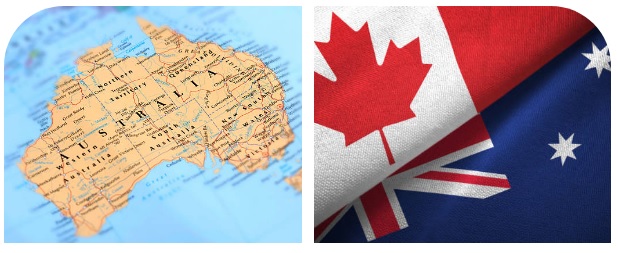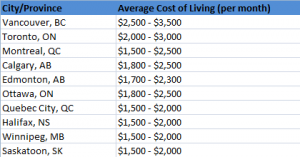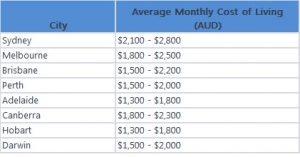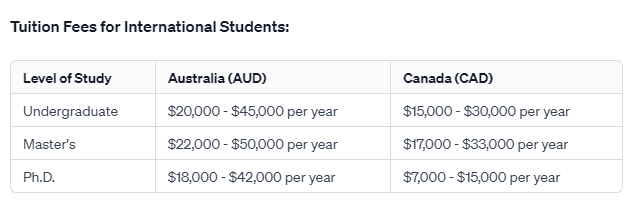
Choosing between Canada and Australia as an international student can be a tough decision. Both countries have a lot to offer in terms of education, culture, and lifestyle. If you consider the expenses Canada is comparatively cheaper than Australia. The tuition fee and the cost of living are pretty much lower than that of Australia.
Canada is known for its high-quality education system and welcoming attitude towards international students. It has many top-ranked universities and colleges, as well as programs that cater specifically to international students. Canada is also known for its natural beauty, multiculturalism, and safety.
On the other hand, Australia is known for its warm climate, beautiful beaches, and laid-back lifestyle. It also has a strong education system, with many highly-ranked universities and colleges. Australia is a popular destination for international students due to its vibrant cities, friendly people, and opportunities for adventure. A new survey of IDP’s recurring Emerging Futures survey collected responses from almost 10000 international students, it has become evident that the student’s
interest is shifting towards Australia. Experts think that excellent quality of education combined with immense job opportunities are key to this gradual shift.
Ultimately, the decision between Canada and Australia will depend on your personal preferences, priorities, and cultural understandings. Consider factors such as the cost of living, climate, cultural differences, and education programs to help make your decision. It’s also important to research visa requirements and job prospects after graduation to ensure that you can achieve your goals in your chosen country. Conducting thorough research on the employability of a particular course will also help to make your career journey fruitful.
The Canadian student visa is subject to the following rules:
Within 90 days of finishing your education, you must apply for a post-graduation employment visa. For Indian candidates, a medical exam is required as part of the visa application procedure in Canada. Spouses who are staying for a year or more can also work full-time. This visa has a $150 application fee. You are not permitted to work more than 20 hours a week. Students may, however, work up to 40 hours per week during holidays, breaks, and summer sessions.
These regulations apply to Australian Student visa
A student visa in Australia is not issued in the form of a sticker. The application fee for an Australian student visa is AUD 650 for undergraduate courses and AUD 680 for postgraduate courses. Spouses only become dependents if the student is pursuing a Master’s or PhD. Spouses of Master’s and PhD students can work an unrestricted number of hours. During their studies in Australia, student visa holders are entitled to work up to 40 hours per fortnight.
1) Educational System:
The Canadian education system is globally acclaimed for its quality and top-ranking universities. Many famous universities are also known for their world-class faculty. 7 Canadian universities ranked among the top 200 universities in the world of which 5 universities are among the top 100 universities. From this ranking alone you can understand the quality of the educational institutions in Canada.
Canada offers numerous programs that are research-oriented and also facilitate continuous education. Canada is a well-performing OCED country with better household income, life expectancy, reading literacy, and math and science knowledge.
Australia is also known for its high-quality education system and top-notch institutions. The Australian education system focuses highly on practical learning which is backed by a strong vocational education system. People from any background can enroll in these vocational courses and get job-ready within months. The highest level in Australia is the university level. Australian Qualification Network, AQF controls and manages various educational institutions.
2) Cost of Living and Tuition Fees:

The cost of living is dependent upon the area of residence of a prospective student. The following is an approximate living expense across various cities in Canada. These estimates cover basic expenses, including accommodation, food, transport, and miscellaneous expenses. Costs can vary based on personal choices, lifestyle, and specific location within the city or province. The following is a comparison between the living expenses of various cities in Australia and Canada.
Canada

Australia

Rent, groceries, transit, internet, and other basic expenses are all included in these statistics. Keep in mind that rent can account for a sizable amount of the total cost, and it varies depending on the kind of housing (sharing, private, on-campus, off-campus) and location within the city. Individual expenditures can also be influenced by personal spending patterns and lifestyle choices.
International students’ tuition prices in Australia and Canada can vary greatly based on the degree of study, the specific program, and the institution. The values presented here are approximations and should only be used as a general reference. It is critical to check with specific universities for the most current and accurate information.

Tuition fees are approximate and may vary depending on the university, program, and subject of study. The fee range provided for each level of study reflects the variation in fees between universities and fields. Tuition fees in Australia are in Australian Dollars (AUD), but tuition fees in Canada are in Canadian Dollars (CAD). Tuition does not include extra charges such as health insurance, textbooks, housing, and living expenses.
3) Work Opportunities for International Students:

Both Canada and Australia provide appealing employment options for international students. The post-graduation work permit program in Canada stands out as a crucial bridge for overseas students seeking to get Canadian job experience after completing their education. Beyond that, the debate delves into the numerous part-time work alternatives accessible throughout studies, laying the groundwork for a potentially seamless transition to permanent residency.
Meanwhile, in Australia, post-study work visa possibilities are being investigated, with a focus on the varied periods that cater to diverse academic interests. A closer look at Australia’s part-time job restrictions reveals a welcoming climate for overseas students, as well as clear paths to permanent residency. Both countries’ employment environments not only improve the overall student experience but also open access to long-term career opportunities.
4 Quality of Life:

When it comes to the quality of life for international students, both Canada and Australia have distinctive and appealing features. Canada’s well-deserved reputation for great quality of life is well-deserved. The numerous cultural experiences that students will encounter provide an enriching atmosphere for personal development. Safety is vital, and it contributes to a general sense of well-being.
Furthermore, Canada’s healthcare benefits and comprehensive social services demonstrate the country’s commitment to its international student community. Australia, on the opposite side of the world, is enticed by its beautiful lifestyle, plenty of outdoor activities, and rich tapestry of cultural diversity.
The attractiveness of the Australian way of life extends to its healthcare facilities and strong social support systems, resulting in a holistic atmosphere that caters to international students’ well-being. Whether surrounded by the breathtaking landscapes of Canada or immersed in the vibrant culture of Australia, both countries prioritize the quality of life for international students. The government agencies are in control and the regulations are intact. It may seem complex still it is effective in managing the quality education system.
5) Immigration policies:
When it comes to foreign student immigration regulations, both Canada and Australia provide appealing prospects, each with its distinct approach. In Canada, the Express Entry system, a dynamic and points-based structure that caters to graduates and others, is frequently used to negotiate the path to permanent residency. This approach guarantees a smooth transition for people who have finished their education in the Great White North. Australia, on the other hand, has its own set of immigration regulations, stressing points-based systems and skilled migration channels. These procedures allow international students to effortlessly move into permanent residency, providing a clear and regulated path for individuals seeking to call Australia home.
These two countries’ contrasting approaches emphasize their dedication to attracting and keeping global talent while providing international students with a rewarding future beyond their academic achievements.
International students must make a thoughtful decision between Canada and Australia based on personal preferences, career goals, and lifestyle considerations. Both countries provide world-class education, various cultural experiences, and pathways to permanent residency, making them appealing destinations for students looking for an enriched academic experience. Canada’s reputation for academic achievement, quality of life, and the Express Entry system make it a tempting option, whereas Australia’s practical skills emphasis, dynamic lifestyle, and points-based immigration system make it stand out. Finally, the “better” option is determined by the student’s individual needs and aspirations.
Whether it’s the scenic landscapes of Canada or the sun-soaked beaches of Australia, the decision should align with one’s personal and professional ambitions, ensuring a fulfilling and successful international student experience.
